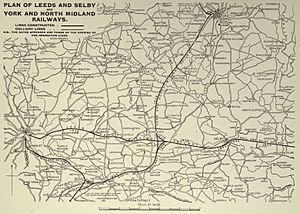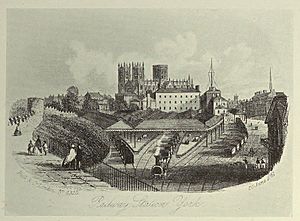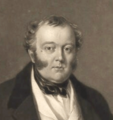George Hudson facts for kids
Quick facts for kids
George Hudson
|
|
|---|---|
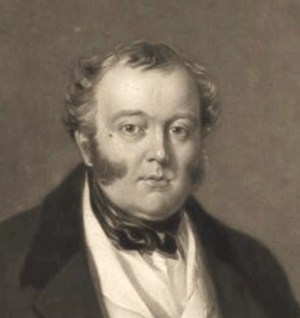 |
|
| Lord Mayor of York | |
| In office 1846–1847 |
|
| Monarch | Victoria |
| Preceded by | William Richardson |
| Succeeded by | James Richardson |
| In office 1837–1839 |
|
| Preceded by | James Meek |
| Succeeded by | William Stephenson Clark |
| Member of Parliament for Sunderland |
|
| In office 1845–1859 |
|
| Personal details | |
| Born | 10 March 1800 Howsham, East Riding of Yorkshire, England |
| Died | 14 December 1871 London, England |
| Political party | Tory |
| Spouse | Elizabeth Nicholson |
| Occupation | Politician |
| Nickname | The Railway King |
George Hudson (born 10 March 1800 – died 14 December 1871) was an English businessman and politician. He was known as "The Railway King" because he controlled a large part of Britain's railway network in the 1840s. This was a time of huge growth in railways, called the Railway Mania.
Hudson helped connect London to Edinburgh by train. He also created the first big merger of railway companies, forming the Midland Railway. He turned his home city of York into an important railway hub. Hudson also served as a Member of Parliament for Sunderland. His success was built on some questionable financial practices. He often paid shareholders using money meant for company growth, not from actual profits.
By 1849, investigations into his companies exposed his methods. Many people who had supported him turned against him. Hudson lost his wealth and became bankrupt. After losing his seat in Parliament, he had to live abroad to avoid being arrested for debt. He only returned to England when laws about debt imprisonment changed in 1870.
Contents
Early Life and Business
George Hudson was born in Howsham, a small village near York, on 10 March 1800. His parents were John and Elizabeth Hudson. He was raised by his older brothers after his parents passed away. He left Howsham at age 15 after a basic education.
Hudson became an apprentice at Bell and Nicholson, a drapery (fabric) shop in York. He finished his training in 1820 and became a partner in the business in 1821. On 17 July 1821, he married Elizabeth Nicholson, the owner's daughter. The company became Nicholson and Hudson and was the biggest business in York by 1827.
In 1827, Hudson inherited a large sum of £30,000 from his great-uncle, Matthew Botrill. This money helped him get involved in the railway business. Hudson also became a respected public servant in York. He helped people during a cholera outbreak in 1832.
Hudson changed his political views and became a High Church Tory. He became the treasurer of the York Conservative Party in 1832. He played a key role in setting up the York Union Banking Company in 1833.
The Railway King's Vision
Building the York and North Midland Railway
In 1833, York businessmen formed a railway committee. Their first idea was to link York to Leeds to get cheaper coal. Hudson was the treasurer and the biggest shareholder. He learned about railway building and dealing with landowners.
In 1834, Hudson met George Stephenson, a famous railway pioneer. They became friends and business partners. Hudson learned about Stephenson's dream of a railway from London to Newcastle, which would bypass York.
In 1835, the York railway committee became the York and North Midland Railway (YNMR). Hudson suggested the new line should join the North Midland at Normanton, near Leeds. The YNMR received official approval on 21 June 1836. Hudson was elected Chairman at its first meeting.
Work on the YNMR line began in April 1837. A new station was built in York. Before the line fully opened, Hudson declared a dividend (a payment to shareholders). He admitted this payment came from the company's starting money, not from profits. Some people disagreed, but others defended him.
The line opened to a junction on the Leeds to Selby line on 29 May 1839. It reached Normanton on 1 July 1840. This meant London was now connected to York by rail. On 9 November 1840, the YNMR leased the Leeds and Selby Railway. Hudson then closed that line so passengers had to use his route via Castleford.
Expanding the YNMR Network
Under Hudson's leadership, the YNMR built more lines. These included lines to Pickering and Scarborough, both approved on 4 July 1844. The existing Whitby-Pickering Railway was bought by the YNMR on 30 June 1845. When the York to Pickering line opened on 8 July 1845, there was a direct route from York to Whitby. The route to Scarborough opened on the same day. Hudson believed Scarborough would become the "Brighton of the north."
On 1 July 1845, the YNMR leased the Hull and Selby Railway. The following year, lines from Seamer to Filey and Hull to Bridlington were finished. The link between Filey and Bridlington was completed on 20 October 1847.
On 20 August 1847, the YNMR line to Harrogate opened. On 4 October, the line from York to Market Weighton was completed. Hudson had bought the Londesborough Hall estate in 1845. This was partly to stop a rival's railway plan.
On 8 May 1848, Hull Paragon station opened. On 20 July, the line from Spofforth to Harrogate was finished. On 1 August, the line linking Selby and Market Weighton opened. A direct line to Leeds was also planned but was abandoned after Hudson's downfall.
Creating the Railway Clearing House
In the early days, each railway was a separate company. This meant passengers often had to change trains and buy new tickets at each stage of their journey. With his strong influence, Hudson played a big part in setting up the Railway Clearing House in 1842. This organization helped manage how money from tickets and cargo was shared among different railway companies.
Forming the Midland Railway
In 1842, the North Midland Railway was in serious financial trouble. Hudson, as a shareholder, took charge of fixing the situation. He cut operating costs by reducing staff and wages. This led to some problems, including an accident in 1843. However, Hudson managed to reduce expenses and increase income.
Two other companies, the Midland Counties Railway and the Birmingham and Derby Junction Railway, were also struggling. They had been fighting a "war of attrition" over fares. Hudson convinced shareholders that merging the three railways would save a lot of money. The merger was agreed in September 1843, and Hudson became the Midland Railway's first chairman. The merger was officially approved on 10 May 1844.
By 1845, the Midland Railway had leased other lines. This meant Hudson's railways linked Gateshead in the north with Bristol in the south. The Midland network continued to expand under his leadership.
In 1843, Hudson also became chairman of the Leeds and Bradford Railway company. This line opened on 1 July 1846 and was immediately leased by the Midland Railway. Some people began to worry about Hudson's methods because he seemed to benefit personally from these arrangements.
Competing with the Great Northern Railway
It's often said that George Hudson wanted all railways to come to York. While he certainly helped many railways reach York, he opposed the Great Northern Railway (GNR) building a direct line to York. He felt it would offer a better route to London than his own.
A rival, Edmund Denison MP, wanted to build a faster link from London to York via Doncaster. Hudson and the Midland Railway fought against the GNR in Parliament. Hudson also got involved with the Eastern Counties Railway to try and create a competing route.
Eventually, Hudson realized he couldn't stop the GNR from reaching York. So, the York and North Midland built a branch line to allow GNR services to reach York. This decision upset many Midland Railway shareholders.
Expanding North from York
Another early railway in York was the Great North of England Railway. They planned to build a line to Newcastle and then to Scotland. By 1841, their plans had stalled.
In 1841, a government report favored a western railway route to Scotland. However, it also said that if a line from Darlington to Edinburgh was built, the western route should be put on hold. Hudson called a meeting and announced his plan to build a line from Darlington to Durham. This would connect to existing lines that went to Gateshead.
By December 1841, the Newcastle and Darlington Junction railway was formed with Hudson as chairman. Work began in 1842. Between 1843 and 1847, various railway companies were bought or merged into the York, Newcastle and Berwick Railway (YNBR).
On 23 May 1844, the building of a high bridge across the River Tyne was approved. On 19 June, the line opened through to Gateshead. Under Hudson's leadership, the YNBR continued to expand, taking over more lines and docks.
Leading the Eastern Counties Railway
Hudson became chairman of the struggling Eastern Counties Railway (ECR) in 1845. The ECR had a very bad reputation for being late and unsafe. Hudson immediately ordered a large dividend payment for shareholders.
Later investigations showed that Hudson decided how much dividend to pay. His vice-chairman, David Waddington, would then change the company's financial records to make it look like the money was earned legally. This led to problems between Hudson and Waddington.
Hudson cut costs on the ECR, similar to what he did on the North Midland Railway. An accident in 1846 led to public criticism. During Hudson's time as chairman, the ECR network grew, with new lines opening to places like Peterborough, Wisbech, and March.
Financial Troubles and Downfall
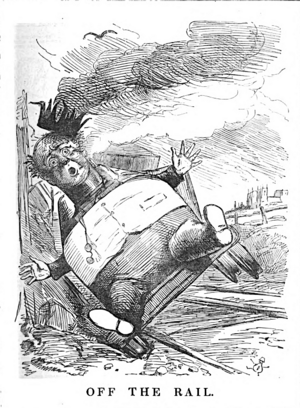
In 1848, a pamphlet claimed that the dividends paid by Hudson's companies came from the company's starting money, not from profits. In February 1849, a Midland shareholder criticized Hudson. This was made worse when Hudson agreed to let the Great Northern Railway use his line, which many felt was a betrayal.
Hudson had been borrowing money at high interest rates to keep some of his companies going. Many companies were in a difficult situation with falling income. In York, the City Council demanded money for a bridge project. Many of Hudson's supporters lost their positions in local elections that year.
The shareholders who had praised Hudson for large dividends now turned against him. At a Midland Railway meeting in February 1849, there were calls for an investigation. Hudson managed to stop it by threatening to resign. However, five days later, at a meeting of the York, Newcastle and Berwick Railway, it was revealed that shares had been sold to the company for much more than they were worth, and Hudson benefited. This time, an investigation committee was formed.
Hudson did not attend the Eastern Counties Railway meeting on 28 February. His vice-chairman, David Waddington, blamed Hudson for the small dividend. Another investigation was set up. Within a month, the Midland Railway shareholders also started an inquiry, and Hudson resigned.
In April 1849, the YNMR report confirmed the wrongful share valuation, and Hudson had to pay back £30,000. He also resigned from the ECR after a hostile inquiry. On 7 May, a Member of Parliament suggested possible bribery of MPs, leading to another inquiry. Hudson spoke to Parliament, but the damage was done.
On 17 May, Hudson resigned from the YNMR to avoid being fired. A committee was set up to investigate if he used company money to build a private station at Londesborough Park. As 1849 continued, more problems were discovered. By autumn, Hudson was asked to repay £750,000. He sold his Londesborough Park estate and paid £200,000 to the YNBR to avoid court.
Despite his troubles, the railway bridge across the Tyne opened in 1849. Monkwearmouth Dock, where Hudson was chairman, opened in 1850. In 1852, the YNMR offered to settle Hudson's debts for £50,000, but he refused. The YNMR then took him to court with three separate cases.
Hudson lost all three cases in 1853. By the end of that year, he agreed to pay £72,670 to clear all his debts. He had to sell his property at Newby Park. By 1856, the YNMR debt was £16,000, which was taken over by the North Eastern Railway in 1864.
Political Career
In York
By 1830, Hudson was a Tory. He supported John Lowther in the 1832 and 1833 elections. In 1835, Hudson was elected as an alderman to the City of York Corporation. With Hudson's financial support, the York Tories gained power. Hudson became Lord Mayor of York in 1836 and again in 1837.
After becoming a Member of Parliament for Sunderland in 1845, Hudson was Lord Mayor of York for a third time. He wanted to build a bridge to connect the railway with Lendal in York. However, his attempts to raise money for this project faced opposition. Hudson eventually agreed to pay some of the design costs himself.
In Sunderland
The Sunderland Conservatives chose Hudson as their candidate in 1845. They hoped he would help improve two struggling projects: Monkwearmouth Dock and the Durham and Sunderland Railway. Hudson won the election and became a Member of Parliament on 14 August 1845.
In Parliament, Hudson worked to protect his railway interests. He also played a key role in repealing the Corn Laws, which were taxes on imported grain.
In 1847, Lord George Bentinck proposed building a railway network in Ireland. Hudson supported this expensive plan, but the government did not, and the bill was defeated.
Hudson faced severe financial difficulties by the 1852 election. He spoke on various issues, including a timber tax and a bill about corrupt practices. He returned to Sunderland for the 1857 election and was re-elected, but with a smaller majority. Between 1857 and 1859, the Sunderland Dock Company struggled, and people in Sunderland became unhappy with Hudson. He lost his seat in the 1859 election. This defeat meant he was no longer protected from imprisonment for debt, so he went into exile.
In Whitby
Hudson lived abroad, sometimes struggling financially. He returned to England in December 1864 for his brother Charles's funeral. Charles had been important in the Whitby Conservative Party. Hudson had to go back to France to avoid his creditors. However, he was chosen to run for election in Whitby in 1865.
Hudson had business interests in Whitby, including property he inherited. He had also formed the Whitby Building Company, which developed the West Cliff area of the town. Hudson hoped to recover this property and start new developments.
Hudson returned to Whitby on 11 June 1865. His opponent was the sitting Liberal MP, Harry Thompson. Thompson was also the chairman of the North Eastern Railway (NER). He was not popular in Whitby because he had not connected the town to the national rail network. Hudson used this to his advantage in a speech on 19 June, and victory seemed likely.
However, on 9 July 1865, just before the election, the Sheriff of York arrested Hudson in Whitby. He was taken back to York. It is believed that Thompson and George Leeman were behind the arrest. The Whitby Conservatives then chose another candidate, Charles Bagnall, who won the election. Hudson was held in York prison.
Final Years
Many people in York and the north felt sympathy for Hudson, who was now 65 and in poor health. He was released in October 1865 when a colliery owner, George Elliot, paid off one of his debts.
Hudson moved abroad again. But when he returned to London in June 1866, he was arrested again and imprisoned for three weeks. He fled the country after being released to see his lawyer. The NER case against Hudson continued without him. His debts were reduced, but the NER appealed, and the original debt was restored in March 1869.
This turn of events gained Hudson public sympathy. Elliot and Hugh Taylor, an MP, started a fund for Hudson, raising £1,000 in three weeks. His friends set up a trust to give him a regular income, protected from his creditors. With the passing of the Abolition of Imprisonment for Debt Act on 1 January 1870, Hudson could return to London and live with his wife.
In 1871, the NER finally accepted they would not get the money owed, and the remaining debt cases were dropped. Hudson's health was poor. He became ill on 9 December 1871 while visiting York. He returned to London by train and died five days later, aged 71. His body was taken by train to York, where many people paid their respects. Hudson was buried at Scrayingham on 21 December, as he wished.
How Others Saw Him
George Hudson was a person who created strong opinions. Thomas Carlyle called him the "big swollen gambler." Many people who had believed in his promises later criticized him. He caused financial problems for investors and himself. However, he truly believed in his plans and managed to overcome powerful landowners.
Charles Dickens wrote about him, saying he felt like "howling whenever I hear Mr. Hudson mentioned."
In 1840, D Morier Evans described Hudson: "He is about five feet six inches in height, of a stout body frame with a short bull-neck, surmounted by a head not conspicuous for intellectuality. His face attracts attention and the expression in his eyes is no peculiar. At first sight one dislikes him…. Notwithstanding the sinister leer of his eye, the ungainly frame and the unharmonious voice, his person however rude exteriorly, is the cover of a fairer mind than was first imagined"
Sir Thomas Legard wrote in 1846: "When railways and railway shares were dark as night, men said that Hudson ruled, and all was right"
Family Life
George Hudson married Elizabeth Nicholson (1795–1886) in 1821 in York. They had four children who survived:
- George (1829–1909), who became a factory inspector.
- John (born 1832), who joined the army and died in the Indian Mutiny in 1857.
- William (born 1834), who became a doctor but died in a train accident in 1876.
- Ann (1830–1874), who married a Polish count.
Elizabeth Hudson died in London in 1886.
Properties Connected to Hudson
1 College Street, York
This was the location of Hudson's drapery shop. When he first married, he lived above the shop. A plaque marks this spot today.
Monkgate, York
Hudson lived at 44 Monkgate with his family from 1827 to 1844. This house had previously belonged to his uncle, Matthew Bottrill. It is now called Hudson House, and a plaque explains his connection to it.
Baldersby Park
In 1845, Hudson bought Newby Park in North Yorkshire. He rebuilt it and renamed it 'Baldersby Park'. The mansion is now home to Queen Mary's School, a girls' independent school.
Albert Gate, London
When Hudson became an MP, he bought a property in Albert Gate in Knightsbridge, London. This became a social hub for the Hudsons in London. Today, it is the French embassy.
Octon Grange near Bridlington
Hudson bought Octon Grange in August 1844 as a strategic investment. He hoped his sons would inherit country houses. This property was also near a proposed railway line to Bridlington.
Londesborough Park Estate near Market Weighton
Hudson bought this estate for £500,000 as an investment for his sons. This purchase stopped a rival's plan to build a railway line. He sold the estate in 1850 to pay off some of his debts.
Churton Street, Pimlico, London
Elizabeth Hudson lived here for many years while Hudson was in exile. Hudson lived here from 1870 to 1871 and passed away at this address.
Memorials and Legacy
Hudson House, built where the old York and North Midland Railway station once stood in York, is named after him. George Hudson Street in the City of York is also named in his honor.
There is a Hudson Street in Whitby and a Hudson Road in Sunderland. Sunderland also has two docks named after him: Hudson Dock North and Hudson Dock South. The former railway line from Market Weighton to Beverley is now a footpath called the 'Hudson Way'. There is also a street in Tadcaster, North Yorkshire, called Hudson Way, near a railway viaduct that was built but never used.
A painting of Hudson from his time as Mayor of York is displayed in the York Mansion House. The painting is in good condition, but its frame, which listed his achievements, has been damaged. This is thought to be the work of people who were unhappy with him after his downfall.
Images for kids
-
George Hudson "Off the Rail" as caricatured in Punch


